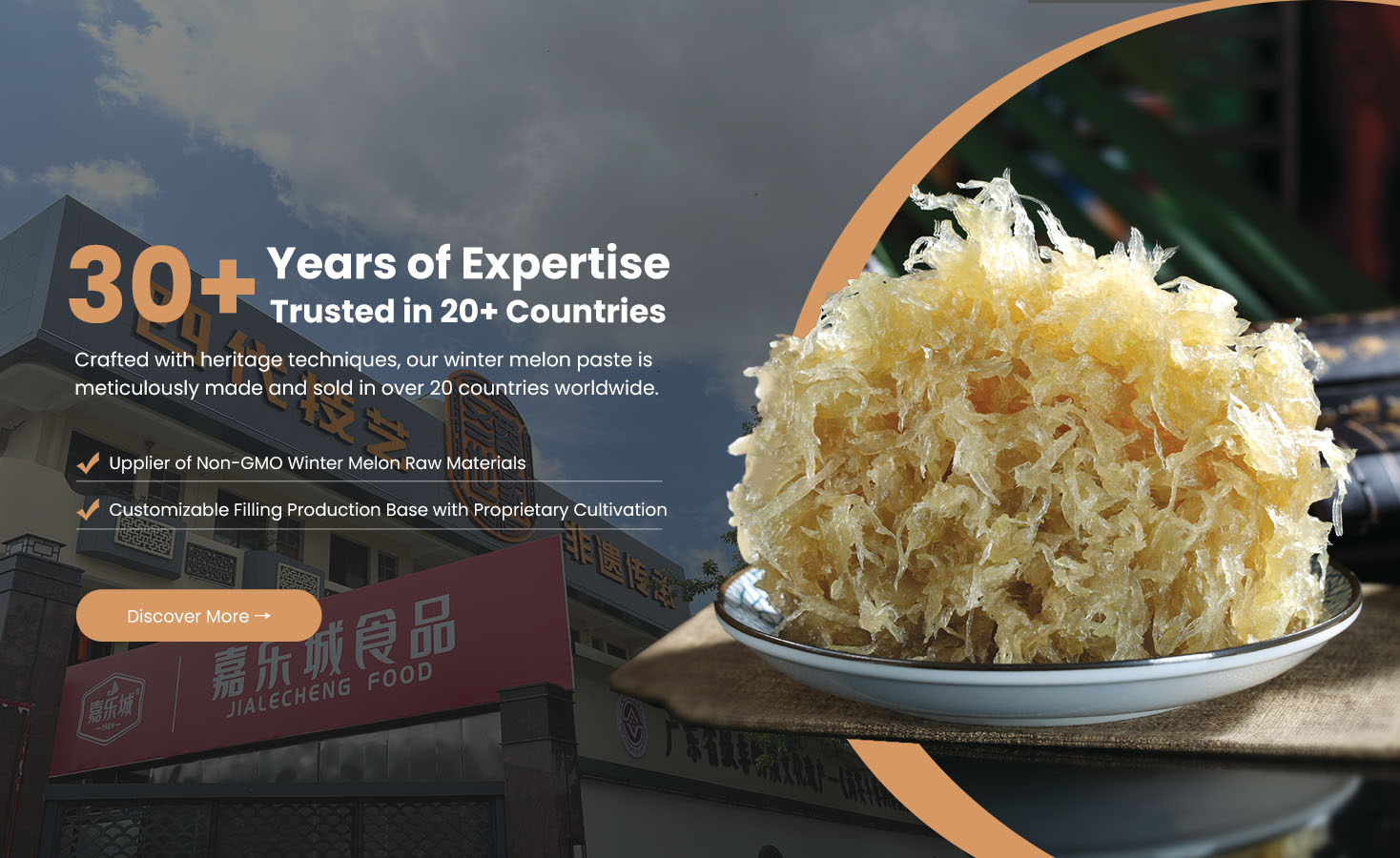How Does Sugar Content Affect The Texture Of Winter Melon Paste?
The sugar content in winter melon paste plays a decisive role in determining its texture, sweetness, moisture balance, gloss, and shelf life. While winter melon is naturally mild and watery, the right amount of sugar transforms it into a smooth, stable, and glossy paste that holds up during baking.
Producers such as Jialecheng Foods have refined this balance through precise formulation — ensuring that every batch of winter melon paste maintains ideal consistency, elasticity, and baking performance for pastry fillings like mooncakes and wife cakes.
1. The Role of Sugar in winter melon paste
Sugar is far more than a sweetener — it acts as a structural and functional ingredient in the paste. During cooking, sugar interacts with water and melon fibers to form a smooth, cohesive mass.
| Function of Sugar | Effect on Paste Texture |
|---|---|
| Moisture control | Binds water molecules and reduces free moisture, preventing the paste from becoming watery. |
| Caramelization | Adds color and deepens flavor as sugars break down under heat. |
| Viscosity increase | Helps the paste thicken and achieve a cohesive, dense consistency. |
| Preservation | Lowers water activity, extending shelf life by inhibiting microbial growth. |
| Gloss enhancement | Contributes to the translucent sheen typical of high-quality winter melon paste. |
Without sufficient sugar, the paste would remain loose, dull, and unstable when baked.
2. How Sugar Affects Texture During Cooking
As the mixture of melon, sugar, and water cooks, several chemical and physical transformations occur:
a. Water Extraction and Softening
Sugar draws moisture out of the melon tissue through osmosis, softening the flesh and allowing it to break down uniformly.
This creates the base for a fine-textured, spreadable paste.
b. Concentration and Gelation
As the water evaporates, sugar concentration increases.
The mixture thickens into a glossy mass, with maltose or glucose syrup helping prevent crystallization.
c. Caramelization and Color Formation
At high temperatures, sugar begins to caramelize, turning the paste a golden amber color and adding mild toffee-like notes.
d. Stability After Cooling
The high sugar concentration stabilizes the paste, making it firm yet flexible when cool — a texture ideal for wrapping inside pastry dough.
3. Sugar Levels and Their Effects
| Sugar Content (% of total mixture) | Texture Characteristics | Suitability |
|---|---|---|
| Low (20–25%) | Soft, loose, watery; poor binding; not glossy | Unsuitable for baking; short shelf life |
| Medium (30–35%) | Smooth, pliable, retains shape; balanced sweetness | Ideal for most bakery fillings |
| High (40–45%) | Dense, glossy, chewy; very sweet and firm | Good for long storage or tropical export |
| Very High (50%+) | Hard, sticky; prone to crystallization | Not recommended; affects spreadability |
Industrial producers like Jialecheng Foods usually maintain 30–35% sugar content, achieving the best balance between elasticity, sweetness, and baking performance.
4. The Relationship Between Sugar and Moisture
The ratio of sugar to water directly controls the texture outcome.
Too little sugar leaves excess free water → paste becomes soft, prone to microbial spoilage.
Too much sugar removes too much moisture → paste becomes tough and less pliable.
Ideal moisture content after cooking: 18–22%, allowing a smooth and moldable consistency.
| Sugar-Water Balance | Result |
|---|---|
| Balanced (≈1:0.5 ratio) | Glossy, firm, and flexible paste |
| Low sugar, high water | Runny, short shelf life |
| High sugar, low water | Hard, sticky, overly sweet |
5. Sugar Type and Its Influence
Different sugars contribute differently to the paste’s mouthfeel and gloss:
| Sugar Type | Function in Texture |
|---|---|
| White granulated sugar | Main sweetener; builds structure and firmness. |
| Maltose syrup | Adds elasticity, prevents sugar crystallization, and increases gloss. |
| Glucose syrup | Retains moisture and improves chewiness. |
| Brown sugar or caramel syrup (optional) | Adds color and a slight molasses flavor. |
The combination of sucrose and maltose is common in commercial production, as it yields a smooth, stable texture that doesn’t harden over time.
6. Industrial Perspective: Jialecheng Foods’ Sugar Control Method
Professional producers manage sugar content through controlled cooking systems:
Precision weighing: Ensures consistency batch by batch.
Vacuum concentration: Reduces water content without overcooking or burning sugar.
Temperature regulation: Prevents crystallization while maintaining caramel color.
Quality testing: Each batch is checked for viscosity and moisture percentage.
This process guarantees a stable, non-grainy paste that performs uniformly in baking and packaging.
7. Summary of Sugar’s Impact
| Aspect | Effect of Proper Sugar Balance |
|---|---|
| Texture | Smooth, elastic, and stable |
| Color | Light golden to amber |
| Gloss | Shiny, translucent appearance |
| Moisture | Controlled softness without stickiness |
| Shelf Life | 6–12 months under vacuum packaging |
| Baking Performance | Holds shape, doesn’t melt or crack |
8. Conclusion
Sugar content defines the identity and quality of winter melon paste. The right balance—typically around 30–35% sugar by weight—creates a paste that is smooth, elastic, and glossy, with just the right sweetness and structure to withstand baking.
When controlled with precision, as in the production systems of Jialecheng Foods, sugar becomes more than a flavoring—it becomes the foundation of texture, stability, and the signature shine that makes winter melon paste a timeless filling in Asian bakery traditions.




